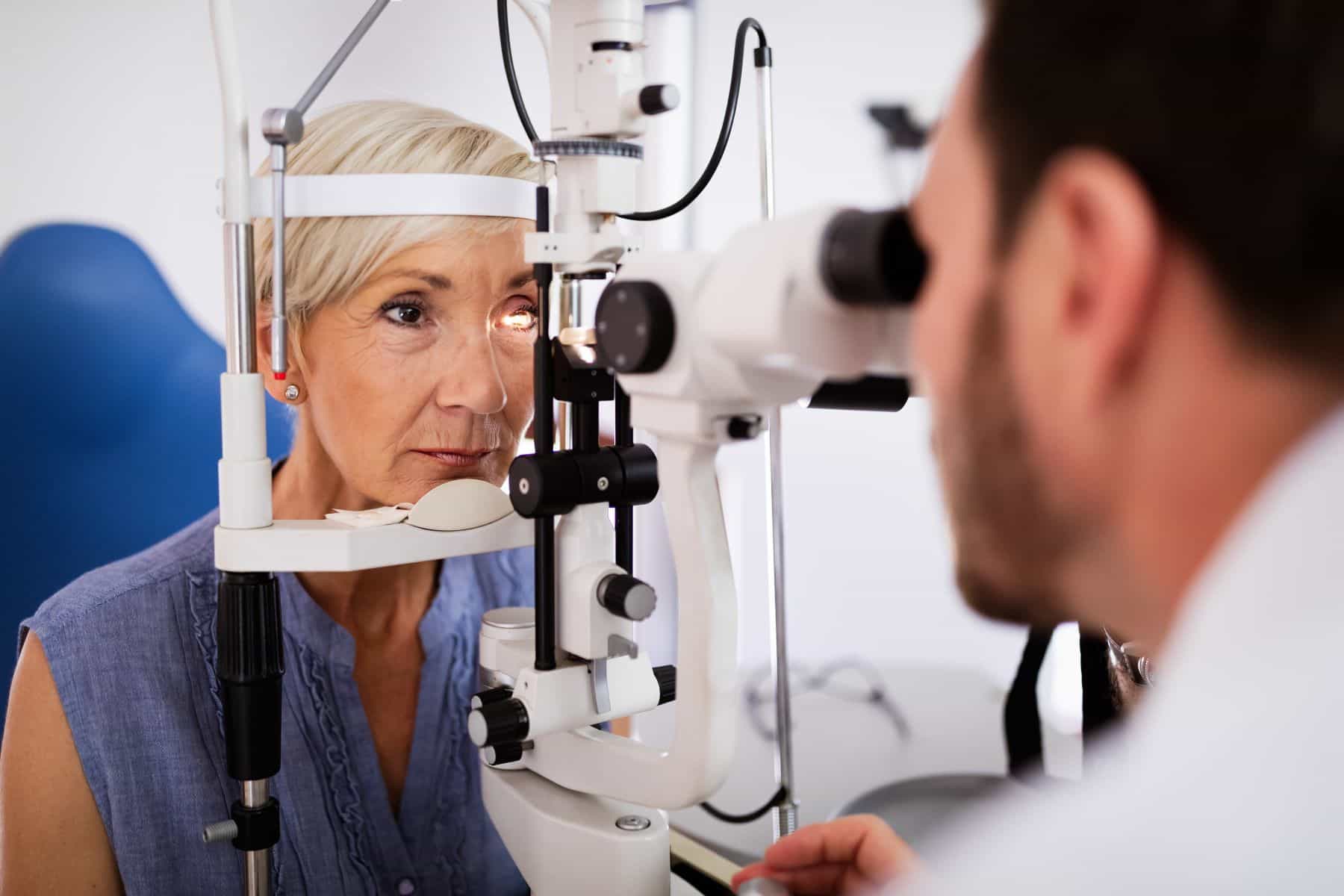Litigation Guides
Elmiron Side Effects & Lawsuits
Long-term use of Elmiron, a medication for interstitial cystitis/painful bladder syndrome is associated with irreversible eye damage, mostly in middle-aged to elderly female patients. Pre-existing eye disease and use of other medications that affect eye health can complicate the association.
Medically Reviewed
What is Elmiron?
Elmiron (pentosan polysulfate) is a medication approved by the FDA in 1996 to treat interstitial cystitis, a painful bladder condition.
Interstitial Cystitis (IC)
IC, also known as painful bladder syndrome, is a chronic condition characterized by bladder pain, urinary urgency, frequency, and nighttime urination (nocturia). Details are described below:1
- The exact cause of IC is unknown, but it is believed to involve damage to the bladder lining.
- Studies suggest that a layer of protective polysaccharide molecules (called glycosaminoglycans) normally shields the bladder lining. Polysaccharides are complex carbohydrates made up of many sugar molecules bonded together,
- In IC, this protective layer is compromised, allowing leakage of urine and irritants into the bladder wall, causing pain and inflammation.
Elmiron's Potential Mechanism in IC Treatment
Elmiron (pentosan polysulfate) is a synthetic polysaccharide structurally similar to natural bladder lining glycosaminoglycans. Details are described below:2
- While the exact mechanism is unclear, Elmiron is believed to bind to the damaged bladder wall, forming a protective barrier.
- This potential barrier restoration may explain Elmiron's effectiveness in treating IC.

Complications from Elmiron Use
Concerns have emerged regarding an association between use of Elmiron and development of an eye disease, as described below:
- Recent independent studies (first published by Emory) suggest a potential link between long-term Elmiron use and a new eye disease called pigmentary maculopathy (PM).3
- PM is a condition that changes the color of the retina, the eye's light-sensitive tissue at the back of the eye responsible for transmitting visual signals to the brain. This can lead to vision problems, ranging from mild to severe, including partial or total loss of vision in certain areas.
Correlations Between Elmiron Use and PM
The current understanding of the Elmiron-PM relationship is based on retrospective studies examining long-term Elmiron users for signs of PM.
- A recent landmark study suggests a correlation between Elmiron use duration and PM risk.4 The risk appears to be particularly elevated for patients taking Elmiron for seven years or more.
- This correlation is supported by a Canadian study where PM patients had been taking the drug for an average of 15 years.5
- A UCLA cross-sectional study identified cumulative Elmiron dosage as another potential factor. A total exposure of 1,500 grams or more was linked to a stronger association with PM.6
Risk factors for IC/PBS and Elmiron-induced PM
Both sex and age influence the risk of developing IC/PBS and Elmiron-induced pigmentary maculopathy (PM) as follows:
Gender Disparity in IC/PBS and Elmiron Use
Interstitial cystitis/painful bladder syndrome (IC/PBS) disproportionately affects females, as can be seen in the following statistics:
- Studies report a prevalence of up to 197 cases per 100,000 women compared to 41 cases per 100,000 men.7
- Clinical trials for Elmiron reflect this gender disparity, with significantly higher recruitment of female participants (2220) compared to males (254).7
- An analysis by Ludwig et al. further supports this trend, finding that nearly 90% of 49,899 IC/PBS patients were female.6
Age Considerations in IC/PBS and Elmiron-induced PM
Elmiron-induced PM is more likely at an older age, even though the average age of IC/PBS is much younger, as described below:
Navigating an Elmiron Case?
We help attorneys access the latest legal research, medical record reviews, physician consultations, and world-class experts.
Confounding Factors in Linking Elmiron to PM
Pre-existing eye problems and medications that harm the retina make it hard to show a direct connection between Elmiron and pigmentary maculopathy (PM), which also affects vision by damaging the retina.
Pre-existing eye conditions
Certain pre-existing eye conditions can mimic the symptoms of PM, potentially leading to misdiagnosis or complicating eligibility in Elmiron-related lawsuits. These conditions include:
- Age-related macular degeneration (AMD) - both dry and wet forms
- Hereditary maculopathies like Stargardt macular degeneration and Vitelliform macular dystrophy
- Diabetic maculopathy - a complication of diabetes where damage occurs to the central part of the retina, leading to potential vision loss
Multiple Medications and Establishing Elmiron Causation
Several medications can cause various forms of maculopathy or retinal damage, making it more difficult to isolate Elmiron as the sole cause of PM when these other medications are also being used. Examples of retinal conditions associated with medication use are as follows:9
- Pigmentary toxicity - this is damage to the pigment (colored) cells in the retina that play a crucial role in vision (e.g., Clofazimine, hydroxychloroquine).
- Crystalline retinopathy - this condition involves formation of crystals within the retina, disrupting its function (e.g., Canthaxanthin, methoxyflurane).
- Photoreceptor dysfunction - this refers to abnormal function of light-sensitive cells (photoreceptors), impairing vision (e.g., Carmustine, cisplatin).
- Macular edema - this condition involves fluid accumulation in the macula, causing blurred vision (e.g., Fingolimod, Latanoprost).
- Central serous choroidopathy - this condition involves fluid leakage from the choroid (a layer beneath the retina), distorting vision (e.g., corticosteroids).
- Uveitis - this is inflammation of the uveal tract (middle layer of the eye) causing pain, light sensitivity, and vision loss (e.g., Dabrafenib, pembrolizumab).
- Retinal vascular damage - this condition is characterized by disruption of blood flow to the retina due to damage in blood vessels, leading to vision problems (e.g., aminoglycoside antibiotics)
Notable Elmiron Lawsuits
Several recent lawsuits highlight the emerging legal landscape surrounding Elmiron and potential pigmentary maculopathy (PM) development:10,11,12,13
- Cukierski v. Janssen Pharmaceuticals, Inc., et al.: This recently filed lawsuit claims long-term Elmiron use resulted in ophthalmic injuries (eye injuries) or other unspecified injuries.
- Friedman et al v. Janssen Pharmaceuticals, Inc., et al.: This case alleges similar injuries from long-term Elmiron use. A "conditional transfer order" suggests the case may be consolidated with other similar lawsuits in a different jurisdiction.
- Reedy v. Janssen Pharmaceuticals, Inc., et al.: Recently filed, this lawsuit alleges ophthalmic injuries and potentially other unspecified injuries stemming from long-term Elmiron use.
- Troutman v. Janssen Pharmaceuticals, Inc., et al.: This recently filed case alleges long-term Elmiron use caused ophthalmic injuries or other unspecified injuries.
Works Cited
1.
Janssen Pharmaceuticals. ELMIRON ® -100 MG (PENTOSAN POLYSULFATE SODIUM) CAPSULES PRESCRIBING INFORMATION [Internet]. 2020 Jun. Available from: https://www.accessdata.fda.gov/drugsatfda_docs/label/2020/020193s014lbl.pdf
2.
Parsons CL. A model for the function of glycosaminoglycans in the urinary tract. World J Urol. 1994;12(1):38-42. doi:10.1007/BF00182049. https://pubmed.ncbi.nlm.nih.gov/8012414/
3.
Pearce WA, Chen R, Jain N. Pigmentary Maculopathy Associated with Chronic Exposure to Pentosan Polysulfate Sodium. Ophthalmology. Published online 2018. doi:10.1016/j.ophtha.2018.04.026. https://www.aaojournal.org/article/S0161-6420%2817%2933695-3/abstract
4.
Jain N, Li AL, Yu Y, Vanderbeek BL. Association of macular disease with long-term use of pentosan polysulfate sodium: Findings from a US cohort. Br J Ophthalmol. Published online 2020. doi:10.1136/bjophthalmol-2019-314765. https://bjo.bmj.com/content/104/8/1093.long
5.
Doiron RC, Bona M, Nickel JC. Possible drug-induced, vision-threatening maculopathy secondary to chronic pentosan polysulfate sodium (Elmiron®) exposure. Can Urol Assoc J. Published online 2020. doi:10.5489/CUAJ.6401. https://www.ncbi.nlm.nih.gov/pmc/articles/PMC7012292/
6.
Ludwig CA, Vail D, Callaway NF, Pasricha M V., Moshfeghi DM. Pentosan Polysulfate Sodium Exposure and Drug-Induced Maculopathy in Commercially Insured Patients in the United States. Ophthalmology. Published online 2020. doi:10.1016/j.ophtha.2019.10.036. https://www.sciencedirect.com/science/article/abs/pii/S0161642019322110
7.
Arora HC, Shoskes DA. The enigma of men with interstitial cystitis/bladder pain syndrome. Transl Androl Urol. Published online 2015. doi:10.3978/j.issn.2223-4683.2015.10.01. https://pubmed.ncbi.nlm.nih.gov/26813678/
8.
Hanif AM, Jain N. Clinical Pearls for a New Condition. Rev Ophthalmol. Published online 2019. https://www.reviewofophthalmology.com/article/clinical-pearls-for-a-new-condition
9.
Abbasi, O., Tewari, A., & Detroit. (2009, June 11). Common medications that may be toxic to the retina. Review of Ophthalmology – Monthly Publication for Ophthalmologists. https://www.reviewofophthalmology.com/article/common-medications-that-may-be-toxic-to-the-retina
About the authors
R. H. Siddiqui, MS, MD, MPH
R.H. is a Strategic Research Manager at Expert Institute. R.H. has a diverse background that spans medicine, public health, biomedical research, and documentary screenwriting. R.H. previously served as a screenwriter on the Emmy Nominated documentary Cancer: The Emperor of All Maladies.
R.H. received his bachelor’s degree from Stony Brook University, his master’s degree in biomedical science from Tufts University School of Medicine, and his master’s degree in public health from Upstate Medical University.
Wendy Ketner, M.D.
Dr. Wendy Ketner is a distinguished medical professional with a comprehensive background in surgery and medical research. Currently serving as the Senior Vice President of Medical Affairs at the Expert Institute, she plays a pivotal role in overseeing the organization's most important client relationships. Dr. Ketner's extensive surgical training was completed at Mount Sinai Beth Israel, where she gained hands-on experience in various general surgery procedures, including hernia repairs, cholecystectomies, appendectomies, mastectomies for breast cancer, breast reconstruction, surgical oncology, vascular surgery, and colorectal surgery. She also provided care in the surgical intensive care unit.
Her research interests have focused on post-mastectomy reconstruction and the surgical treatment of gastric cancer, including co-authoring a textbook chapter on the subject. Additionally, she has contributed to research on the percutaneous delivery of stem cells following myocardial infarction.
Dr. Ketner's educational background includes a Bachelor's degree from Yale University in Latin American Studies and a Doctor of Medicine (M.D.) from SUNY Downstate College of Medicine. Moreover, she is a member of the Board of Advisors for Opollo Technologies, a fintech healthcare AI company, contributing her medical expertise to enhance healthcare technology solutions. Her role at Expert Institute involves leveraging her medical knowledge to provide insights into legal cases, underscoring her unique blend of medical and legal acumen.
Subscribe to our newsletter
Join our newsletter to stay up to date on legal news, insights and product updates from Expert Institute.
Speak with an Ophthalmology Expert
We're here to help you build a stronger case. Retain a leading expert witness today.
Access tailored expertise on every case
Trust your expert immediately
Speak with your expert before retaining
Need your medical records reviewed? Consult one of our 75+ on-staff physicians who can help evaluate the strengths and weaknesses of your case.





